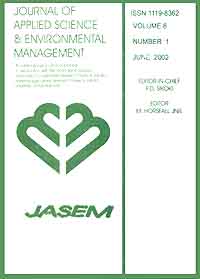
|
Journal of Applied Sciences and Environmental Management
World Bank assisted National Agricultural Research Project (NARP) - University of Port Harcourt
ISSN: 1119-8362
Vol. 24, No. 10, 2020, pp. 1711-1714
|
 Bioline Code: ja20246
Bioline Code: ja20246
Full paper language: English
Document type: Research Article
Document available free of charge
|
|
|
Journal of Applied Sciences and Environmental Management, Vol. 24, No. 10, 2020, pp. 1711-1714
| en |
Effect of Planting Date on the Growth, Fibre and Seed Yield of Kenaf ( Hibiscus cannabinus  L) in Ibadan, South Western Nigeria L) in Ibadan, South Western Nigeria
OLANIPEKUN, SO & TOGUN, AO
Abstract
Planting of kenaf usually commences from March - April as these months mark the onset of the rainy
season in Nigeria. On the contrary, it is now difficult for anyone to predict when rain start due to climatic variation. Hence,
field experiments was conducted between 2015 and 2016 to determine the appropriate time of sowing kenaf that will
optimize its yield potential in South Western Nigeria. As a result of delay in the commencement of rain, planting did not
start until May. Hence, kenaf seeds were sown in May, June, July and August at 30 days interval in each year. The
experiment was a 4 × 2 factorial laid out in a randomized complete block design and replicated three times. The result
indicated that the highest fibre yield (1.00 t/ha) was from the kenaf sown in June irrespective of the year, but not
significantly different from the one sown in July (0.98 t/ha). On the other hand, kenaf sown in July had the highest seed
yield (2.28 t/ha) with the lowest seed yield (1.04 t/ha) obtained in May followed by August (1.19 t/ha). The experiment
conclusively affirm June for sowing of kenaf for fibre cultivation and July for seed production.
Keywords
Planting date; kenaf; fibre and seed yield
|
| |
© Copyright 2020 - Olanipekun and Togun
|
|
